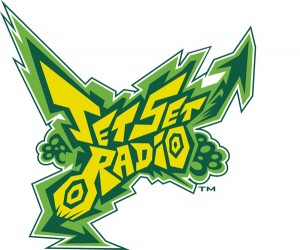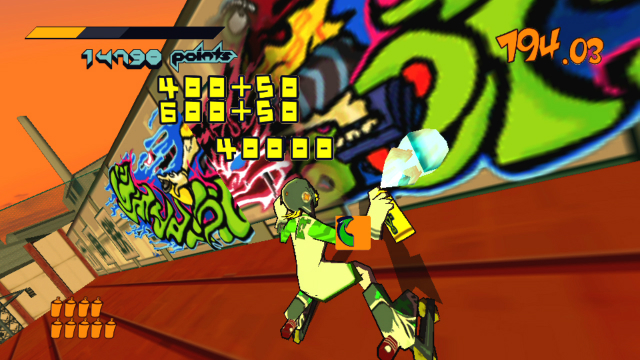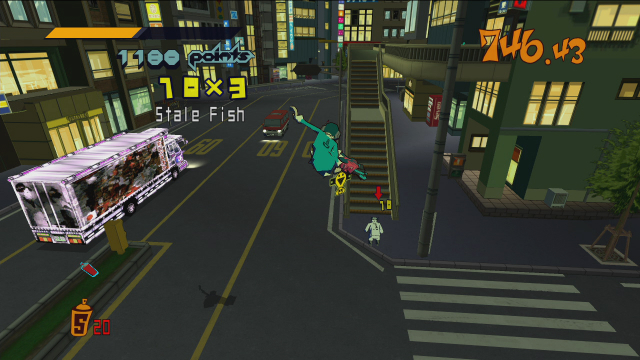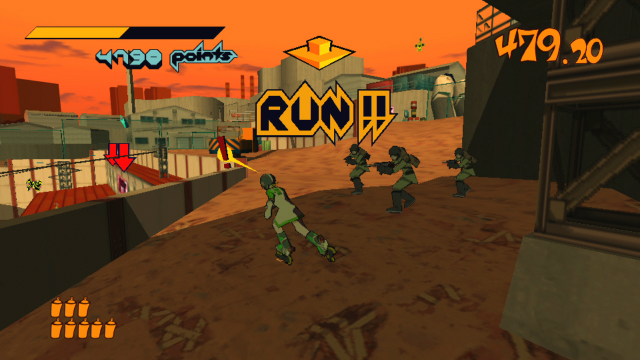Jet Set Radio HD Review
 Game:Jet Set Radio HD
Game:Jet Set Radio HD
Developer: SEGA
Publisher: SEGA
Available on: PlayStation Network, Xbox LIVE Arcade, PC, Android, iOS
Reviewed on: Xbox LIVE Arcade
Jet Set Radio is one of those games whose style, like it or hate it, smacks you square in the face right away and makes you notice it.
Even now, in a totally different era for gaming, where ultra-realistic facial tracking is meant to make our jaws drop, the cel-shaded style and frantic action of JSR still stands out from the crowd as radical, unique and eye-catching.
The setting is Tokyo-To, a city where skate gangs are fighting one another for domination of the streets; by tagging areas and out-tricking one another. All the while, Tokyo-To Major Goji Rokkaku and the Police force, led by Captain Onishima, are trying to stop the “Rudies” from desecrating their city. The gangs are all kept in the loop by Rastafarian radio DJ, Professor K, who acts as narrator in the game, linking together the story missions and informing the player of developments in the game world. It might not be Shakespeare, but the plot serves well enough to loosely link the levels together. As with many SEGA games, whose roots were firmly in the arcades, gameplay takes priority over story.

This high definition re-working doesn’t try to mess with the basics, we more or less just receive an audio-visual overhaul. Aside from the crisp edges and new HD resolutions, there are a few changes made, native widescreen is included, rather than the letterboxing or 4:3 borders many retro games suffer from. The game really does still look fantastic, and keeps a great frame rate, whilst the cartoon-like cel-shading doesn’t age as poorly as polygons or pixels have in the past. Animations are smooth and expressive, and the game is full of colour, unlike so many modern games that are so rooted in browns and greys; the graphics look timeless and could have been created far more recently than twelve years ago.
Audio is, of course, a huge part of the game, hence the “Radio” name, and thankfully the huge soundtrack of licensed music has been kept largely intact. Consisting of Japanese-inspired jams, hardcore dance music and a few punk-esque tunes, the eclectic mix fits the game perfectly, and certainly keeps up with the buzzing, high-tempo gameplay. The fact that so many of the songs were licensed, makes it impressive that SEGA still took the effort to acquire them all (bar two songs) whereas, for their Crazy Taxi HD makeover, a whole new soundtrack was applied, in a move that many long-time fans were furious about. At least it seems that SEGA are stepping up their efforts, and really want to do their retro games justice. This is highlighted further by a ten-minute documentary video that they have created and added along with the game, which talks to some of the developers and looks at how the game came to be. A nice bonus for fans of gaming past.
The bulk of the gameplay is made up of cruising through different districts of the city, and covering up the graffiti tags of other gangs; all whilst trying to avoid the law. Players first take control of Beat, an in-line skater who is looknig to form his own gang, and is soon joined by two other skaters. As you progress through the game, you will recruit more characters, each with a different blend of health, speed and graffiti skills. The higher your graffiti skill, the bigger the score you can amass on a level. Pulling off tricks such as grinds and wall-rides will also score you more points, as well as helping you reach high or out-of-the-way areas that can’t be reached normally. To clear each level you must find and cover all opposing gang tags within a set time limit, without the police either knocking you out, or capturing you.

Speaking of the police, they are hilarious. From the Monty Python-like basic troopers, to the be-quiffed Onishima, all the way up to the cute, cartoony tanks that certainly look more humorous than intimidating. There is some really strong character design which is – as is the design throughout the game – vivid and imaginative. A skating game may not be the most original idea, and the controls even feel a little bit awkward and inaccurate, but the game looks, sounds and feels like nothing else from the time, or that has come in the years since. The detection for landing grinds is sometimes annoying, and judging your jumps can become a real frustration, especially when you try to dash and it doesn’t always kick in, but most of these are minor issues, that won’t detract from the game as a whole.
For the high-def re-vamp, SEGA has thankfully changed the camera control from the Dreamcast version. Sometimes the camera just wasn’t that helpful before. Ok, you could always tap a trigger to centre it behind the character, but sometimes a bit more freedom is called for, so now the second analog stick controls camera rotation, whilst the first is solely movement. On top of that, there have been the usual online Leaderboards and Achievements/Trophies added to the title. However, more interestingly, some of the new graffiti designs in the game have been created by fans, and included in the update. Of course, any player can use the in-game graffiti editor to create their own tag too; which is a nice touch.

Additions such as Leaderboards might make the game a slightly longer experience, and create some competitiveness among the really good players out there, but the game isn’t short by any means, and to complete it to its fullest will take quite some time; it is actually a pretty tough game to play. There will be a lot of tags that you have to clear in any one level (luckily any you haven’t already cleared are marked on a handy map in the pause menu), and you really have to work out the best route in which to approach the level so that you can tag every spot in the time limit you are given. The more tags you place, the more intense the police presence becomes so you also have to work out which are the most difficult tags to reach and handle them whilst the police are still fairly harmless, leaving the easy ones to be mopped up when things are getting more hairy. Add to that the fact that you have to manage how many cans of paint you currently have, and if that will be enough to tag the areas you want to, and the whole thing is quite a precarious balance that has a steep learning curve as levels soon start to get more tricky. Even clearing the Tutorial will take a while, as some big trick combos are required in order to pass that. It becomes frustrating, but no more so than nailing a tricky combo in Tony Hawk’s, and maybe that is one of the things that made this game so good back in its heyday.
VERDICT: It feels like a cool, casual game, but it is constantly throwing challenging jumps or police chases at you, not letting you relax for one second as you play through a level. It may look slick graphically, and when you pull off a great move, stringing together a series of tricks and tags it looks impressive, but some real practice and learning of the levels will be needed to do that. It is a testament to the design of the game that it both still looks great and is a challenging gameplay experience, after so many years; let down only by some temperamental controls. Be warned, this isn’t as easy as some modern skate games, but is far more rewarding. With this release, SEGA have finally shown just how a good HD remix should be done.





